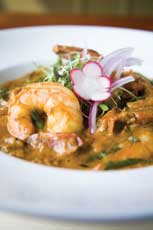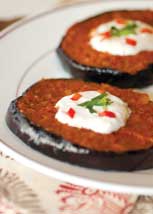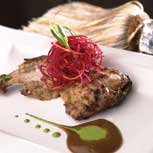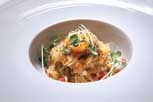

Leena Trivedi-Grenier
A plate with an unfamiliar blackened disc makes its way to the table. It looks almost charred on the outside, with a bright orange interior. The fork gently breaks through the slightly crisp exterior to find the soft, succulent center; the first bite tastes smoky and meaty like lamb, except the creamy morsel melts in your mouth like a triple crème cheese. The waiter passes by and whispers the words “vegetarian foie gras”; and that is when you know – this is not your average Indian restaurant.
The “vegetarian foie gras” is actually tandoori portobello mushrooms served with a yogurt, cashew and tamarind sauce from Lachu Moorjani’s restaurant, Ajanta, in Berkeley. Moorjani is among a handful of chefs from across the country, focusing on serving a fashionable, refined version of Indian fare.
These pioneering chefs are committed to showing people that Indian food can be more than just naan and butter chicken. A dish could be as straightforward as updating an Indian classic, such as the lamb entrée, rogan josh, or as complicated as using Indian flavors and ingredients in a French recipe like crème brûlée.
In Moorjani’s case, his tandoori portobello mushroom combines a traditional Indian technique of marinating food in tandoori paste, then cooking the dish in a tandoor oven, with a popular Bay Area ingredient, the portobello mushroom. By fusing a foreign preparation with a local product, Moorjani was able to create a vegetarian dish that could satisfy even a carnivore’s appetite.
Indian Food 101
Ajanta’s form of inventive and sophisticated fare has only recently entered the mainstream of ethnic dining, leaving rice and curry on most Americans’ minds when choosing Indian cuisine. Although these dishes may be two of the more common components associated with Indian cooking, in reality the region’s cuisine is quite complex. The diverse cultures within the country, exemplified by the predominantly Muslim and Hindu areas, are not the only contributors that help define the Indian cuisine of today. The country’s daily eats boast origins from several other ethnic and religious influences, such as Afghan and Persian in the North, Southeast Asian and African in the South and British throughout the region.
Indian chefs tend to blend their own specialty spice mixes that are frequently used in recipes, such as curry powder or garam masala. Many Indian families have their own family masalas, or spice blends, especially when it comes to chai, or Indian tea. A cooking method particular to Indian cuisine is blooming spices in hot oil before cooking, which helps intensify their flavors.
Other common Indian ingredients include rice, flat breads cooked on a griddle or in a tandoor oven, and legumes such as lentils and chickpeas for protein. Many seasonal fruits and vegetables are preserved into chutneys, pickles and sauces that are served as condiments with the meal.
There are many reasons that Indian food is seeing a resurgence in interest. For one, the American palate continues to grow more varied as increasing numbers of immigrants move into the country, diversifying the population and creating a desire for trying new flavors. Anjan Mitra, owner of Dosa restaurant in San Francisco, also feels there is a large population of first generation Indian Americans who grew up eating traditional Indian food, and, consequently, many of these adults have become interested in exploring a more modern version of their childhood cuisine.
Updating the Classics: Curry 2.0
At Neela’s in Napa, Chef and Owner Neela Paniz’s updated version of the traditional dish, mutter paneer, is a great example of how chefs throughout the West Coast are putting a contemporary spin on classic Indian fare. Why did she decide to develop a new dish instead of creating a conventional course that would be familiar to customers? Her mutter paneer was a creative act of efficiency.
While making paneer for sandwiches at a tea party, Chef Paniz ran out of time, so she decided at the last minute to turn the paneer into a meatloaf. She stirred in the traditional mutter paneer ingredients (tomatoes, onions, peas), then added eggs and cream, topping the dish with breadcrumbs before baking. She cut the paneer loaf into slices, garnishing each serving with homemade tomato chutney, thus creating her popular dish, mutter paneer deconstructed. Chef Paniz also puts an updated twist on her desserts, serving the traditional Indian rice pudding, kheer, with a hint of Grand Marnier to give it a sophisticated turn.
Other chefs have chosen to renew time-honored Indian dishes by swapping in locally sourced ingredients that are organic and sustainable whenever possible. For instance Ajanta, opened since 1993, went completely organic three months ago. Although this is a recent development, Chef Lachu has been creating green-friendly variations on tandoori chicken for years. He substitutes ordinary chicken with sustainable scallops, sourced directly from Monterey Fish Market in Berkeley; creating a dish that is incredibly simple: moist and lightly charred, meaty and intensely flavorful. His spices and Indian ingredients are also locally sourced from Vik’s Distributors of Berkeley, California.
Indian ingredients in non-Indian recipes
Other ways chefs have been creating fine Indian dining is by substituting Indian ingredients in non-Indian recipes and with non-Indian cooking methods. Chef Kuldeep Singh of Origin India in Las Vegas has mastered this form of cooking. His Moulard duck confit with butter-poached potatoes is made with traditional French techniques, but the duck is enhanced with Indian flavors like ginger, garlic, cinnamon and orange zest, while the potatoes get a treatment of the sweet and sour kumquat marmalade similar to chutney.
The creativity of these restaurants extends beyond the kitchen all the way to the bar. Several establishments have created unique cocktail menus inspired by Indian flavors. Origin India mixologist, Alyssa Anderson, recently created a Gulab-tini, a fusion of the popular cocktail the martini and the Indian dessert gulab jamun, which is made of fried dumplings soaked in rose water syrup.
At San Francisco’s Dosa, their Spice-Route cocktails are driven by the flavor of Indian seasonings. The Bloody Mary Curry is a popular drink, combining the traditional spicy tomato cocktail with the complex flavors of curry leaves, green chiles, and Soju, a Korean distilled alcoholic beverage made from rice.
Indian Cuisine meets variety of dining preferences
The bold flavors and spices of Indian cuisine can be daunting to a cautious eater. One of the ways that upscale Indian restaurants have overcome this roadblock is by presenting their food in a menu style familiar to the consumer. Dosa, which focuses on Southern Indian cuisine, does a great job of this in their weekly brunch menu. By using a format the American consumer enjoys – brunch – owner Mitra is able to expose customers to a wide range of Southern Indian breakfast, lunch and snack cuisine including Indian omelets, dosas and chaats (fried snacks) they might otherwise have missed.
Executive Chef and owner Sachin Chopra of Sakoon in Mountain View, California, has also tried packaging his blend of traditional and contemporary flavors in a form familiar to customers – a tasting menu. He offers small portions of several dishes from the restaurant’s extensive selection of reinvented recipes. Highlights from Sakoon’s tasting menu include their avocado jhalmuri aloo, or mashed potato salad with avocado and dried mango vinaigrette, and their lime and coconut dessert soup, served with caramelized lychee and almond brittle.
DIY upscale Indian
For chefs looking to experiment with Indian flavors, Chef Paniz suggests really exploring each spice on its own to understand how it works and what it adds to a dish. Mitra recommends using ginger, garlic, cumin, ground coriander seeds and turmeric as a basic masala, adjusting the amount you use based on your tolerance of spices.
Whether you wish to update a classic Indian dish, use Indian ingredients in a non-Indian recipe or serve Indian cuisine influenced by a variety in dining experiences, there is a demand and market for experimenting with Indian cuisine and flavors. Today, the Number One condiment in the United States is salsa, a staple Latin American recipe; it’s only a matter of time before chutney joins that list.
Leena Trivedi-Grenier is a professional food writer from the San Francisco Bay Area. She is a graduate of The University of Adelaide/Le Cordon Bleu Masters in Gastronomy program, where she researched U.S. food blog user behavior. Her writing has appeared in The Business of Food: Encyclopedia of the Food and Drink Industry, and will appear in upcoming titles from Greenwood Press including Icons of American Cooking and Food Culture of the World Encyclopedia. She is also the creator of Leena Eats This Blog (www.leenaeats.com/blog). Her life will never be the same after Moorjani’s tandoori mushroom.








Ground Ginger Adrak
Asafoetida powder Hing
Cumin seeds Jeera
Coriander seeds Dhania
Green Cardamom Eliachi
Black Mustard seed Rai
Cinnamon Taj
Tumeric power Haldi
Hot Spice Mix Garam Masala
Dried Fenugreek Methi
Dried Mango powder Amchur
Black Pepper Kala Mirchi
